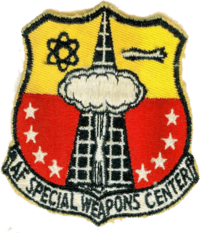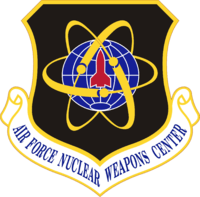Air Force Nuclear Weapons Center
| Air Force Nuclear Weapons Center | |
|---|---|
|
Air Force Nuclear Weapons Center emblem | |
| Active |
1946-1976 2006-Present |
| Country | United States |
| Branch | United States Air Force |
| Type | Nuclear Experts |
| Role | Combat Support |
| Size | Center |
| Part of | Air Force Materiel Command |
| Garrison/HQ | Kirtland Air Force Base |
| Commanders | |
| Current commander | Major General Scott Jansson |


The Air Force Nuclear Weapons Center (NWC) is a USAF Named Unit, assigned to the Air Force Materiel Command at Kirtland Air Force Base, New Mexico. The NWC operates at the Air Division level of the AFMC. It is currently under the command of Major General Scott Jansson.
Mission
The center's mission is to ensure safe, secure, and reliable nuclear weapon systems to support the National Command Structure and the United States Air Force warfighter.
The NWC’s vision is to be the Air Force’s Center of Excellence for all nuclear weapon systems activities. The responsibilities of the NWC include acquisition, modernization and sustainment of nuclear system programs for both the Departments of Defense and Energy.
Overview
Established on March 31, 2006, the Nuclear Weapons Center (NWC) is Air Force Materiel Command’s (AFMC) center of expertise for nuclear weapon systems. The NWC is the single AFMC voice for integrating nuclear weapon systems requirements and nuclear weapon system resource management. The center is the primary unit servicing Kirtland Air Force Base and its over 100 tenant units.
- The 377th Air Base Wing furnishes the talent, resources, equipment and facilities to support the Kirtland Air Force Base community – active duty members, retirees, dependents and civilians. That support includes supply, finance, medical care, housing, civil engineering, fire protection, administrative support, personnel services, legal assistance, transportation, security and law enforcement.
- The 498th Nuclear Systems Wing is responsible for nuclear material on Kirtland Air Force Base. The 498th Munitions Maintenance Group provides this support through the 898th Munitions Squadron. The squadrons perform in-depth maintenance on Air Force and Department of Energy assets from around the world. Their objective is to deliver all munitions and support to the correct location on time and in prime operating condition.
History
The Air Force Nuclear Weapons Center was initially formed as a post World War II outgrowth of the Manhattan Project, which was designed by the Army from the outset to be a temporary organization to produce an atomic bomb. With the end of the war, the establishment of the "Z Division" at Sandia Base and later the Sandia National Laboratory led to the establishment of an Air Force organization to coordinate military activities with the civilian research organization in 1946.
Initially part of Continental Air Command and Air Material Command, the center was established as the Air Force Special Weapons Command as a Major Command of the United States Air Force on 1 December 1949. It was equal to the Air Defense Command, Strategic Air Command, and Tactical Air Command. It assumed all functions of the World War II Atomic Tactical and Technical Liaison Committees, its mission was to provide an organization for the development and testing of atomic weapons. The nucleus of this organization was composed of the pioneering Air Force agencies which had located there to determine future employment of nuclear weapons.
The SWC was headquartered at Kirtland AFB. The mission was to provide an organization for development testing of special weapons, including atomic, biological, and chemical weapons, and to increase the efficiency of airborne vehicles to carry these weapons. As a result, the responsibility for biological-chemical warfare research was moved from Wright-Patterson AFB to the SWC at Kirtland. The SWC assumed all the functions of the old USAF Field Office for Atomic Energy [TandTLC] and employed personnel who were transferred from that office to form the cadre of the HQ, SWC. The command was also directed to provide personnel and equipment for development and proof testing of aircraft equipment and ground handling appurtenance to special weapons. Shortly after it was established, the SWC took over the host responsibilities for Kirtland from Air Materiel Command.[1]
SWC served as the primary source for scientific and technical information on special weapons development. To accomplish its mission, SWC redesignated numerous units that had been under the USAF Field Office of Atomic Energy with no change in station. SWC units at Kirtland in 1951 were:[1]
- 4901st Special Weapons (later Support) Wing (Atomic)
- 4925th Special Weapons (later Test) Group (Atomic)
- 4905th Maintenance and Supply Group
- 4910th Air Base Group
It appears that the 4901st Special Weapons Wing had administrative control over the groups, with the 4905th Maintenance and Supply Group and the 4910th Air Base Group serving as support and the base host, respectively, while the 4925th Special Weapons Group was the group actively involved with atomic testing.[1]
In January 1950 President Harry S. Truman directed the Atomic Energy Commission to emphasize thermonuclear research, with the prime objective to become operational in delivering hydrogen bombs. The primary USAF group to work on this mission was the 4925th Special Weapons Group. The 4925th Special Weapons Group was a mix of elite U.S. airmen and support personnel tasked with testing all aircraft in the USAF inventory for nuclear weapons delivery capability. The top bomber and fighter pilots in the USAF and expert support personnel were transferred to the 4925th Special Weapons Group. In July 1951, the 4925th Special Weapons Group was redesignated the 4925th Test Group (Atomic) and continued for 11 years as an important component of Kirtland ’s nuclear responsibilities.[1]
SWC’s responsibilities expanded in July 1951 to include monitoring the Military Weapons Effects Program, the ongoing series of full-scale nuclear tests, and exercising overall control over participating USAF personnel. The 4930th Test Support Group was "a holding cadre for USAF participating personnel of overseas nuclear testing Joint Task Forces" [1]
The command was redesignated the Air Force Special Weapons Center (AFSWC) and assigned to Air Research and Development Command on 1 April 1952, losing major command status and became a subordinate unit of the Air Research and Development Command.
As the AFSWC, it became one of the distinct research and development centers within the command. Its mission was to ensure the atomic capability of aircraft and missiles. During the 1950s, assigned personnel and aircraft participated in atmospheric nuclear tests in Nevada and the Pacific Proving Grounds. The first Air Force scientific capabilities at the base were created during the mid-1950s. Biophysicists deliberately flew aircraft through nuclear clouds to determine radiation hazards. Engineers also launched sounding rockets so physicists could study the effects of high-altitude nuclear explosions and the nature of the recently discovered Van Allen radiation belts around the Earth.
From the early years of Cold War, the need to test and evaluate supersonic aircraft technologies, associated munitions, and eventually space systems, required the Air Force to build specialized ground test facilities. As nuclear weapons and electronics became more a part of air power, two new locations for Test and Evaluation (T&E) were created. The Special Weapons Center (SWC) at Kirtland Air Force Base, New Mexico concentrated on the technologies supporting nuclear weapons development.
Hanscom Air Force Base, Massachusetts concentrated on new levels of sophistication in electronics and avionics development. However, both locations were closed for testing in the late 1970s because the Air Force felt that limited Research and Development funds were better spent on technology than on infrastructure.
One aspect of the testing environment involves the features a particular location might offer that could help (or hinder) testing of weapons such as supersonic aircraft technologies, associated munitions, and space systems. For example, the Special Weapons Center was established at Kirtland Air Force Base, New Mexico because of the concentration of technologies and industries supporting nuclear weapons development in the region.
In 1958 Special Weapons Center scientists began to simulate the effects of nuclear explosions in order to strengthen our missiles, missile sites and aircraft against possible enemy attack. It was in 1958 that a nuclear effects simulator was first constructed in an abandoned dining hall at Kirtland.
In the wake of the signing of the Partial Nuclear Test Ban Treaty in 1963, the Air Force Weapons Laboratory (AFWL) was created from the Research Directorate elements of the Special Weapons Center. The Special Weapons Center gave up much of its research and development work to the newly created Air Force Weapons Laboratory. The Center continued with its test and evaluation mission and as Kirtland's host organization. The Weapons Laboratory built facilities during the 1960s to simulate nuclear effects such as transient radiation, X-rays, and electromagnetic pulse (EMP).
The Special Weapons Center took over management of Air Force Systems Command's test and evaluation facilities at Holloman Air Force Base near Alamogordo, New Mexico, during the summer of 1970. And, just one year later on 1 July 1971, Kirtland merged with Manzano and Sandia Base, its neighbors to the east, creating the sprawling military complex known as Kirtland Air Force Base. The center then began providing base support services and continued to do so for the next five years, while Field Command, Defense Nuclear Agency, became a major base tenant rather than the base host organization.
Because of budget restrictions and the need to save money, the Air Force Special Weapons Center was disestablished on 1 April 1976. In 1976 AFSWC was closed and OPR functions came to the AFWL. Special Weapons Center's responsibilities as Kirtland's "landlord" were also transferred to the Air Force Contract Management Division on the same day.
On March 31, 2006, the Air Force reactivated the unit as the Nuclear Weapons Center.
Lineage
- Established as: 428th Army Air Forces Base Unit (Flight Test) (later: Special) and activated, 1 February 1946
- Re-designated as: 2758th Air Force Base Unit, 28 August 1948
- Re-designated as: 2758th Experimental Wing, 1 June 1949
- Established as the Special Weapons Command (a USAF Major Command), and activated on 1 December 1949
- 2758th Experimental Wing becoming subordinate unit
- Re-designated: Air Force Special Weapons Center (lost Major Command status) on 1 April 1952
- Inactivated on: 1 April 1976
- Re-designated: Nuclear Weapons Center on 14 February 2006
- Activated on: 31 March 2006
- Re-designated: Air Force Nuclear Weapons Center on 29 February 2008
Components
- 377th Air Base Wing, 31 March 2006 – Present
- 498th Nuclear Systems Wing, 31 March 2006 – January 2012
- 2758th Experimental Wing, 1 December 1949
- Re-designated: 4901st Special Weapons Wing, 1 December 1949
- Re-designated: 4901st Support Wing (Atomic), 1 July 1951
- Re-designated: 4900th Air Base Group (later Wing), 1 April 1952-1 April 1976
- 4910th Air Base Group, 1 December 1949 – 1 May 1955
- 4925th Special Weapons Group, 1 December 1949
- Re-designated: 4925th Test Group, 1 July 1951-31 August 1961
- 4950th Test Group (Nuclear), 1 September 1956 – 16 August 1961.
Assignments
- 58th Bombardment Wing, 1 February-1 December 1946
- Air Force Materiel Command, 1 December 1946
- USAF Field Office of Atomic Energy, 28 August 1948
- Headquarters United States Air Force, 1 Dec 1949
- Air Research and Development (later, Air Force Systems) Command, 1 Apr 1952-1 Apr 1976
- Air Force Materiel Command, 31 Mar 2006–Present
Stations
- Kirtland Air Force Base, New Mexico, 1 February 1946 – 1 April 1976; 31 March 2006 – Present
References
![]() This article incorporates public domain material from the Air Force Historical Research Agency website http://www.afhra.af.mil/.
This article incorporates public domain material from the Air Force Historical Research Agency website http://www.afhra.af.mil/.

